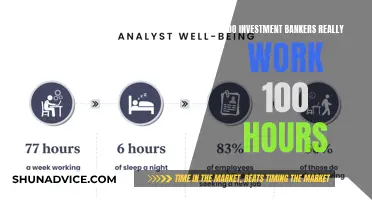
If you're looking to invest $1,000, there are a variety of options to consider. Here are some of the most common ways to invest your money:
- Pay off high-interest debt: If you have credit card debt or other high-interest loans, paying these off should be a priority. By reducing the amount of interest you owe, you can save money and free up more funds for future investments.
- Start an emergency fund: Building an emergency fund is crucial for your financial health. Aim to save between three and six months' worth of living expenses in a high-yield savings account to prepare for unexpected costs, such as medical bills or car repairs.
- Invest in the stock market: You can invest in individual stocks or consider stock index funds, which offer more diversity and lower costs. Some of the best stocks to invest in right now include Microsoft, Apple, Nvidia, Alphabet Inc., Amazon, and Meta Platforms.
- Open a retirement account: Contributing to a retirement plan, such as a 401(k) or an Individual Retirement Account (IRA), is a great way to save for the future. If your employer offers a 401(k) match, take advantage of this to boost your savings.
- Robo-advisors: If you want a more hands-off approach, consider using a robo-advisor. These online services will automatically invest your money for you based on your goals and risk tolerance.
- Fractional shares: Fractional shares allow you to invest in a portion of a share rather than buying a whole share. This makes it more accessible to invest in your favourite companies without spending a lot of money.
| Characteristics | Values |
|---|---|
| Amount | $1,000 |
| Type of Investment | S&P 500 index fund, 401(k), IRA, stocks, savings account, etc. |
| Risk | Low, medium, high |
| Returns | 10% average over time, 3% savings account interest rate, 5% high-yield savings account, etc. |
| Timeframe | Short-term, long-term |
| Accessibility | Easy, medium, hard |
| Fees | Low, high |
What You'll Learn

Pay off high-interest debt
If you have $1,000 to invest, one of the best ways to use it is to pay off any high-interest debt you may have. This is especially true if you have credit card debt, which often has interest rates of 18% or more.
High-interest debt can be expensive to carry and challenging to pay off. The higher the interest rate, the more expensive your debt is likely to be over time, and the longer it may take you to pay it off. This is because of compound interest, which occurs when interest is added back to your principal balance at the end of a set cycle. Credit card interest is typically compounded daily, meaning that high-interest credit card debt builds quickly and can become more difficult to manage the longer it goes unpaid.
If you have high-interest debt, consider these strategies to help you pay it off:
- Make more than the minimum monthly payment. Paying only the minimum will likely cost you more in interest in the long run. Aim to pay more than the minimum each month to make a bigger impact on what you owe.
- Use the debt avalanche repayment method. Rank your debts in order of interest rate and focus on repaying the highest-interest debt first. Then move on to the debt with the next-highest interest rate, and so on. This method can help you save money in the long run by reducing the amount of interest you pay over time.
- Consider debt consolidation. If you have multiple sources of high-interest debt, you can combine them into a single new loan, ideally with a lower interest rate and more favourable repayment terms. Be sure to research your options carefully and feel confident that your new loan will save you money in the long run.
Remember, paying off high-interest debt is a wise financial decision that can provide a better return on your money than almost any investment.
Where to Invest: Industries to Back Now
You may want to see also

Start an emergency fund
Starting an emergency fund is a great way to protect yourself from unexpected financial emergencies. Here are some steps to help you get started:
Set a goal:
Determine how much money you want to have in your emergency fund. A common guideline is to save enough to cover three to six months' worth of essential expenses, such as food, utilities, housing, and transportation. This will provide a financial buffer in case of income loss or unexpected costs.
Create a savings habit:
Consistency is key when it comes to building your emergency fund. Set up automatic recurring transfers from your checking account to your savings account. You can also put aside a specific amount of cash on a regular basis, such as daily, weekly, or on payday.
Monitor your progress:
Regularly check your savings balance to stay motivated and adjust your contributions as needed. Set up automatic notifications or write down your contributions to track your progress.
Celebrate your successes:
Recognize your achievements along the way. When you reach a savings milestone, find a way to treat yourself, and then set your next goal.
Manage your cash flow:
Keep track of your income and expenses to identify opportunities to save. Adjust your spending and savings habits accordingly. For example, you can work with your creditors to change due dates for bills or take advantage of weeks when you have extra money to boost your savings.
Take advantage of one-time opportunities:
If you receive a large sum of money, such as a tax refund or a cash gift, consider allocating a portion of it to your emergency fund.
Save through work:
If you receive a regular paycheck, ask your employer about direct deposit options. You can often choose to split your paycheck between your checking and savings accounts, making it easier to save without having to think about it.
Remember, your emergency fund should be easily accessible and kept separate from your day-to-day spending money. It's there to provide peace of mind and financial security when unexpected expenses arise.
Inheriting Wealth: How to Invest
You may want to see also

Invest in yourself
Investing in yourself is about actively working towards your personal growth and well-being. This can mean learning new things, honing your skills, or ensuring you are mentally and physically healthy. It's about setting goals that are important to you and committing to becoming the best version of yourself.
- Embrace lifelong learning: Education doesn't end when you leave school. You can always build your skill set and feed your passions with lifelong learning. There are many ways to access new information, such as online courses, money tips, resources, and tools.
- Prioritize your mental health: Make your mental health a priority by regularly checking in with yourself to manage stress levels and prevent burnout. Give yourself permission to take breaks, make mistakes, and set boundaries.
- Find a financial mentor: A financial mentor can help you navigate your money and get closer to reaching your financial goals.
- Keep a journal: Journaling is a safe space to reflect, plan, visualize, and forgive. It can also help you manage stress, identify issues, and solve problems.
- Practice gratitude: Practicing gratitude can help you gain perspective and feel more comfortable with where you are in life.
- Break bad habits: Make a list in your journal of all the reasons why you want to break a bad habit and the steps you will take to achieve this.
- Get organized: Establish an effective organizational system for your finances, office, and home.
- Cut out clutter: Go through your social media accounts and only follow accounts that inspire, educate, or make you laugh. Do the same with the people, items, food, and habits in your life.
- Create and maintain a budget: Spend a month tracking your finances in a money diary, list your expenses, and then develop a budget that is attainable and will help you reach your financial goals.
By investing in yourself, you are not just improving your life, but you are also better equipped to positively impact others. It's a journey that helps you handle whatever life throws your way and grab opportunities, leading to a more satisfying and balanced life.
Investments: Where Does the Money Go?
You may want to see also

Buy fractional shares
Fractional shares allow you to invest in a dollar amount rather than a number of shares. For example, if you invest $50 in a stock but a whole share costs $100, you'd own half a share. This makes it easier to diversify your portfolio, even with a small amount of money.
Fractional shares are available through online brokers such as Schwab, Fidelity, and Robinhood. These brokers allow you to buy a portion of a stock that you might not otherwise be able to afford. For example, at Schwab, you can buy what the company calls a "Stock Slice"—a single slice or up to 30 slices at a time of any S&P 500 stock for as little as $5 per slice, commission-free. With Fidelity's Stocks by the Slice program, you can access more than 7,000 U.S. stocks and exchange-traded funds (ETFs) for as little as $1. Robinhood and Interactive Brokers also offer fractional share trading starting at $1, and eligible stocks and ETFs trade for more than $1 per share and have a market value of more than $25 million.
Fractional shares are also available for dividend stocks and exchange-traded funds (ETFs). Dividends received from fractional shares will be proportional to your ownership interest. For example, if you invest $25 in a $100-per-share stock with a dividend of $1, your dividend will be only $0.25. ETFs are index funds that can be traded throughout the day like stocks, and they offer an easy way to diversify your portfolio. Buying multiple ETFs through fractional shares adds another level of diversification.
One benefit of investing in fractional shares is that it makes it easier to dollar-cost average, which is a strategy of investing a set amount at regular intervals to ensure that you buy more shares when prices are low and fewer shares when prices are high. Fractional shares also take the emotion out of investing, as you are investing based on a dollar amount rather than the number of shares.
However, there are a few downsides to fractional shares. If you want to transfer your assets to a new broker, you will likely need to sell any fractional shares as they may not be transferable. Additionally, as a partial shareholder, you typically have no voting rights, and there may be tax implications, fees, or other unforeseen costs associated with selling fractional shares.
Saudi Women's Rights: Investors' Dilemma
You may want to see also

Open a robo-advisor account
Robo-advisors are digital platforms that provide automated, algorithm-driven investment services with little to no human supervision. They are a good option for those who want to invest but don't have the time or knowledge required to make financial decisions.
Step 1: Choose a Robo-Advisor
Robo-advisors differ in their complexity, asset offerings, account minimums, and costs. It's important to do some research to find the one that best suits your needs and financial goals. Some popular robo-advisors include Wealthfront, Betterment, and M1 Finance.
Step 2: Complete the Sign-Up Process
After choosing a robo-advisor, you will need to provide personal information such as your name, address, phone number, email address, and Social Security number to create an account. You may also be asked to complete a risk-profiling questionnaire to evaluate your financial situation, time horizon, and investment goals.
Step 3: Fund the Account
Once your account is set up, you will need to link your bank account and provide the necessary financial information, such as your bank's routing number, to fund the robo-advisor account.
Step 4: Monitor Your Investments
Even though robo-advisors have automated features like rebalancing, it's a good idea to regularly monitor your account to ensure it aligns with your investment goals and risk tolerance.
Robo-advisors offer a convenient and low-cost way to invest, but it's important to remember that they may not be suitable for more complex financial needs, such as estate planning. Additionally, they may lack the human touch and empathy of traditional financial advisors.
C-Corp: Why Investors Choose This Structure
You may want to see also
Frequently asked questions
Vertex Pharmaceuticals (NASDAQ: VRTX) is a safe haven if the stock market falls and has multiple growth drivers.
Microsoft Corp. (MSFT), Alphabet Inc. (GOOG, GOOGL), Amazon.com Inc. (AMZN), Meta Platforms Inc. (META), and Eli Lilly and Co. (LLY) are all solid choices.
You could open a high-yield savings account, invest in a money market fund, or buy treasury bills.
You could put it in a retirement plan, such as a 401(k) or IRA, or open a certificate of deposit (CD) account.
You could use a robo-advisor, which will automatically invest your money for you based on your goals and risk tolerance.







